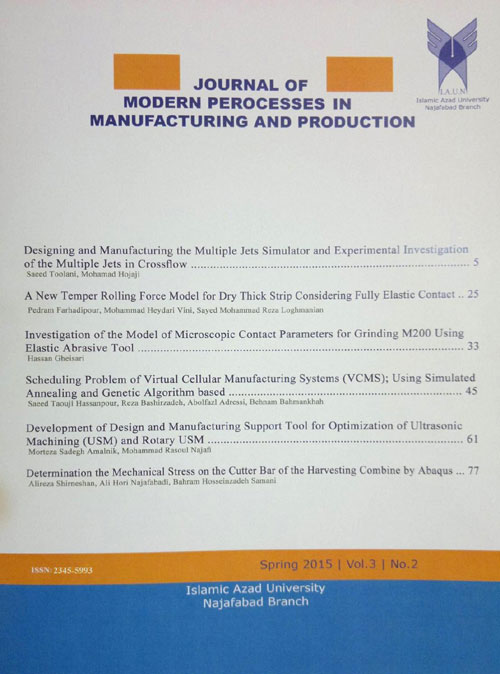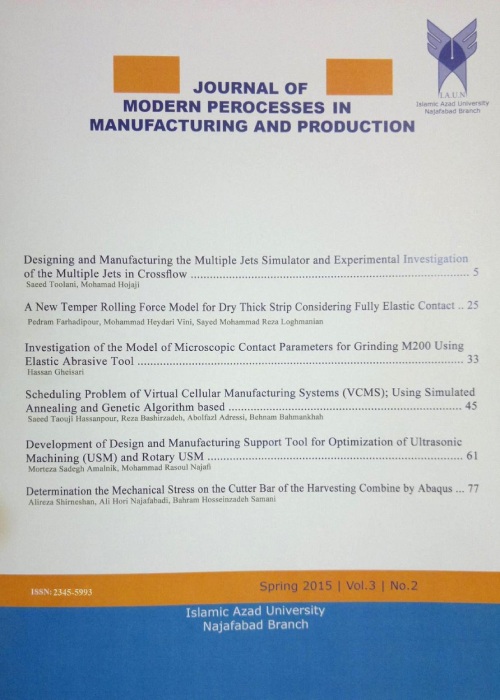فهرست مطالب

Journal of Modern Processes in Manufacturing and Production
Volume:11 Issue: 2, Spring 2022
- تاریخ انتشار: 1401/05/25
- تعداد عناوین: 6
-
-
Pages 5-16
Reverse Engineering in the field of material science is considered one of the most important topics, The process is very complicated and depends on different factors. In this work, new software was developed to calculate the microstructure features of metals and alloys such as grain size number, the average diameter of grain, number of particles per unit area, and number of particles per unit volume. The volume fraction and the terms related to volume fraction such as shape factor, edge-to-edge spacing, and distribution of secondary phases were detected by the point count technique. Both quantitative and qualitative analyses were done. The microstructure features were calculated for the selected samples and compared with the standard photos stored in the program, The comparison depends mainly on comparing each constituent characteristic. The chemical composition comparison was taken into account, The C++ and MATLAB environment were used as a tool in this work which can work under Windows or Linux. The new technique has different applications in metallurgy, industry, medicine, and alloy design.
Keywords: detection, Software, Microstructure, qualitative, quantitative, Reverse engineering -
Pages 17-35Various parameters can affect shot peening such as the number of particles and distance between particles and the surface layer. In this computational study, these parameters' effects on the creation of residual stress and mechanical behavior of Ti-6Al-4V alloy were described. For this purpose, Molecular Dynamics (MD) method is applied in two main steps. First, the simulated titanium surface was equilibrated for 1 ns. Next, the shot peening process was done on the equilibrated surface by using the various numbers of particles and distance. MD simulation results indicated, that by increasing the number of particles from 1 to 5, the mechanical behavior of the titanium surface was improved, and residual stress and hardness of the surface increased and reached 452.02 MPa and 494.46 HV in model 1 (Lj potential between particle and titanium surface), respectively. Furthermore, the results indicated that decreasing the distance from 15 Å to 5 Å led to increasing compressive residual stress and hardness of titanium surface mechanical. Numerically, by decreasing the shot peening distance from 15 Å to 5 Å, residual stress and hardness of titanium surface layer increased and reached -419.63 MPa and 510.83 HV in model 1, respectively.Keywords: Shot Peening, Residual stress, Interatomic Force-field, Mechanical Improvement, Embedded Atom Model, Lennard-Jones potential
-
Pages 37-48Modern industrial production and transportation systems require agile material handling systems. Changing requirements demand flexibility in transportation layout and control systems that are adaptable to the actual needs. Decentralized control systems promise complexity reduction and dependability while centralized approaches improve planning and allow general optimization. By using the use case of a cross-docking logistic system the paper describes how this approach can be combined and implemented by using an agent-based control system on a decentralized lightweight microcontroller infrastructure. The scenario applies to manufacturing environments with modularized assembly lines. These modules are connected by different transport units which merge into an intelligent infrastructure including AGVs, conveyors, and storage.Keywords: MFS, Flexible Logistic System, AGV, In-house transportation
-
Pages 49-60Residual stress measurement is important in composite components. Due to the non-uniform structure of the composite components, the measurement of residual stress in these components cannot be easily performed. In this study, the composite components of polyester resin with glass fiber were presented as a novel structure for a vehicle segment. These materials are manufactured by hand layup method and will generate residual stresses after curing. To calculate the number of residual stresses generated in these parts, the combined central hole drilling-digital image correlation method was used. This method has advantages over drilling by installing a rosette strain gauge. To measure the residual stresses of the desired piece, the drill was positioned on the set, and three points of bending have been done. Then the experimental test conditions are simulated in the ANSYS finite element software. By comparing the results of the experimental test and software simulation, the residual stress values in composite components were calculated with good accuracy.Keywords: Residual Stress Measurement, Composite, Hole Drilling, Digital image correlation
-
Pages 61-69In the present study, experimental investigations were conducted to find out the effect of abrasive water jet machining (AWJM) process parameters on the surface roughness (Ra) of white Makrana Marble. The approach was based on Taguchi’s method and analysis of variance (ANOVA) to optimize the AWJM process parameters for effective machining. Nozzle transverse speed, water pressure, and stand of distance were selected as the input parameters while the other was kept constant. It was found that the water pressure and nozzle transverse speed were significant control factors and the stand of distance was the insignificant control factor in controlling the surface roughness (Ra).Keywords: Surface Roughness, AWJM, Taguchi Method, White Marble
-
Pages 71-84Applying numerical methods in the analysis of forming processes, results in the prediction of the process parameters without performing costly and time-consuming laboratory test procedures. The purpose of this study is to evaluate the feasibility of manufacturing a dental drill body using a hydroforming process. Due to the hygienic issues, the selected material for this part is stainless steel grade 304. The main reason for applying stainless steel in the main body is its hygienic characteristics such as antibacterial surface and washability which makes it appropriate for use in many medical instruments. The hydroforming process is simulated in ABAQUS software and the required parameters of the initial material are obtained from engineering tables. The thickness of the initial part is 0.5 mm and after simulation, it is decreased to 0.38mm. The maximum Von Misses stress of the part reached in this simulation is 708 MPa and the maximum strain rate is 1.233 mm/mm.Keywords: stainless steel, FEM simulation, Abaqus Software, Tube Hydroforming Process


